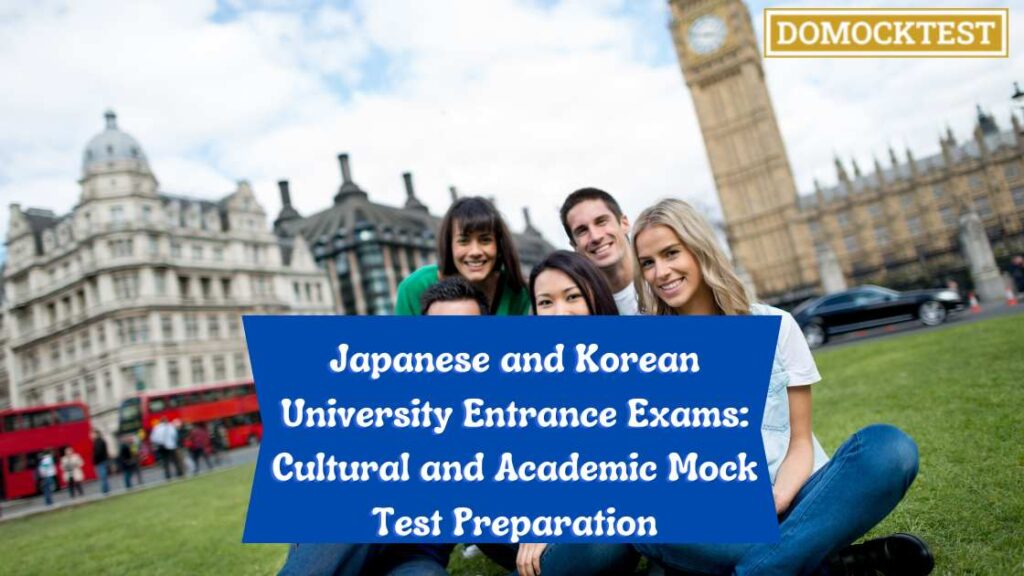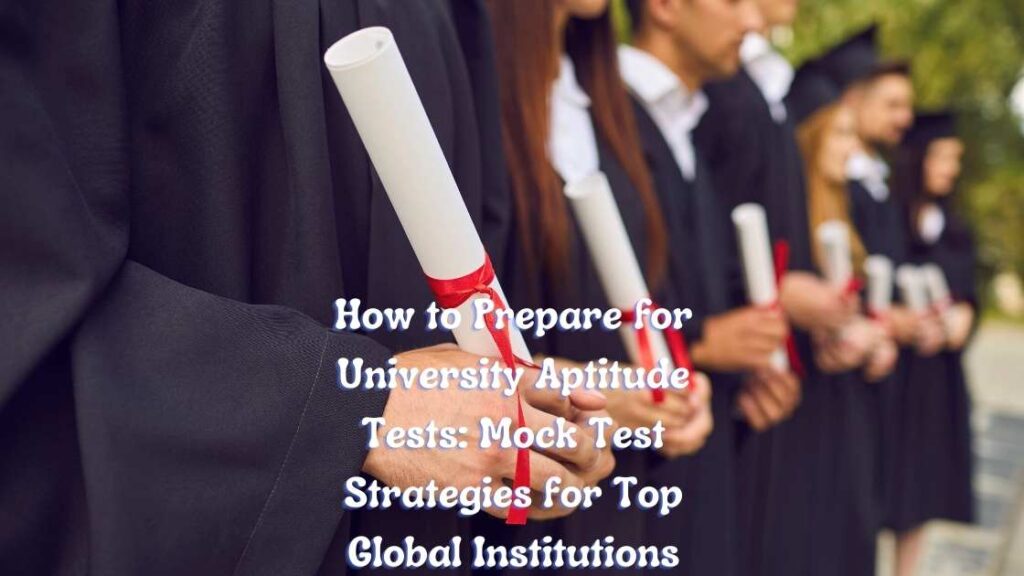Published on: April 19, 2025
University entrance exams in Japan and South Korea are among the most rigorous and competitive in the world. These exams are not only academic assessments but also cultural milestones that shape the educational and professional trajectories of millions of students. Preparing for these exams requires a deep understanding of both academic content and cultural expectations, and one of the most effective strategies is through targeted mock test preparation. This article explores how mock tests can support students aiming to succeed in Japanese and Korean university entrance exams, while considering the unique academic demands and cultural nuances of both countries.
Overview of Japanese and Korean University Entrance Exams
Japanese Entrance Exams
Japan’s university entrance process typically involves two phases:
- The National Center Test (or the newer Common Test for University Admissions): Administered in January, this test covers a range of subjects, including Japanese, mathematics, science, social studies, and foreign languages (mainly English).
- University-Specific Exams: After the common test, each university administers its own entrance examination, often including written essays, math problems, science questions, and interviews. Prestigious universities like the University of Tokyo and Kyoto University have some of the most challenging individual tests.
Korean Entrance Exams
South Korea’s primary university entrance examination is the College Scholastic Ability Test (CSAT) or Suneung, held annually in November. The CSAT assesses:
- Korean language
- Mathematics (with two types: humanities and science)
- English
- Social studies/science/vocational education
- Second foreign language or Chinese characters
The Suneung is a national event, with special accommodations across the country to ensure students can perform their best. It is extremely high-stakes and determines entry into top institutions like Seoul National University, KAIST, and Yonsei University.
The Importance of Mock Tests in Exam Preparation
Mock tests are an essential preparation tool for students facing these high-pressure entrance exams. They serve multiple purposes:
- Familiarity with Format and Timing: Repeated practice with the actual structure and length of the exams.
- Content Mastery: Reinforcement of subject knowledge and identification of weak areas.
- Performance Strategy: Helps develop pacing, stress management, and prioritization skills.
- Cultural Conditioning: Mock tests also acclimatize students to the seriousness and expectations of real exam day.
In countries like Japan and South Korea, where exam performance significantly influences future social and career status, mock test preparation is viewed not just as a tactic, but as a necessity.
Cultural Context: Understanding the Academic Pressure
Japan
Japanese students often begin preparing for entrance exams as early as junior high school. The term “juken” refers to the entrance exam process, and “ronin” refers to students who take a gap year to prepare after failing to gain admission the first time.
Cultural Factors:
- Deep respect for education and academic achievement
- Parental pressure and societal expectations
- Long hours at “juku” (cram schools)
South Korea
Korean students experience immense pressure to succeed in the Suneung. Many attend after-school academies known as “hagwons”, sometimes studying until late at night.
Cultural Factors:
- Emphasis on education as a status symbol
- Hierarchical importance of university rankings
- Nationwide disruption during Suneung day to support test-takers
Crafting a Mock Test Strategy for Japanese Exams
- Understand the Dual Nature of the Exam System:
- Begin with preparation for the Common Test (formerly Center Test), then shift to university-specific materials.
- Utilize official past papers released by the National Center for University Entrance Examinations.
- Focus on Language and Reading Comprehension:
- Japanese language sections are dense and require strong reading skills.
- Mock tests should simulate the complexity and length of these passages.
- Practice Subject-Specific Exams:
- Universities like Tokyo and Kyoto focus on analytical and problem-solving skills.
- Use mock tests that mirror university-specific papers.
- Integrate Cultural Knowledge:
- For essays and interviews, mock sessions should include discussions on social issues, ethics, and Japanese history.
- Time Management Drills:
- Many students struggle with completing sections on time.
- Timed mock tests should be done weekly in the final months.
- Utilize Cram Schools Effectively:
- Many juku offer simulation exams that mirror real tests.
- Opt for mock tests with scoring rubrics similar to university standards.
Building a Mock Test Strategy for Korean Exams
- Simulate the CSAT Schedule:
- The CSAT lasts nearly eight hours.
- Full-day mock tests prepare students for physical and mental stamina.
- Balance Among Core Subjects:
- Students often excel in one area and underperform in others.
- Mock tests should help diagnose and balance strengths.
- Master the Listening Sections:
- English and Korean listening sections require audio practice.
- Mock tests with high-quality audio components are essential.
- Develop Test-Day Discipline:
- Replicate exact time slots and breaks of the real exam.
- Avoid distractions to build focus endurance.
- Train for Multiple-Choice Accuracy:
- CSAT questions are known for tricky phrasing.
- Practice eliminating distractors and managing time effectively.
- Participate in National Mock Exams:
- Organized several times a year by education boards.
- These exams provide percentile rankings to compare against peers.
Academic Tools and Resources for Mock Test Preparation
- Past Papers and Official Resources:
- Japan: Common Test samples and university-specific past papers
- Korea: EBS textbooks aligned with CSAT content
- Test Prep Books:
- Japan: Z-Kai, Benesse, Tokyo Shoseki
- Korea: Megastudy, Daesung, Etoos
- Online Platforms:
- Korea: EBS Online, Megastudy
- Japan: Study Sapuri, Atama Plus
- Tutoring and Coaching Centers:
- Local cram schools (juku/hagwon) specializing in entrance exam mock simulations
- Personalized feedback and tailored strategies
- Mobile Apps:
- Vocabulary builders, listening drills, grammar quizzes
- Apps like Memrise, Duolingo, and local apps tailored to Japanese/Korean syllabi
Psychological Preparation Through Mock Testing
Mock tests also play a key role in developing mental resilience. Both countries report high levels of exam stress and anxiety. Here’s how mock testing helps:
- Desensitization: Repeated exposure reduces anxiety.
- Routine Building: Simulates test-day structure.
- Confidence Boost: Seeing score improvement fosters optimism.
- Error Acceptance: Encourages growth mindset by normalizing mistakes during practice.
Parental and teacher involvement in post-test reviews is common and culturally encouraged in both countries.
Timing and Frequency of Mock Tests
- Early Stage (12-18 months before exam):
- One mock test per month
- Focus on broad content coverage
- Mid Stage (6-12 months before exam):
- Two mock tests per month
- Emphasis on weak areas and test-taking strategies
- Final Stage (1-6 months before exam):
- Weekly mock tests
- Full-day simulations for CSAT, Common Test, and university-specific exams
Common Mistakes in Mock Test Preparation
- Over-Testing Without Review:
- Students may take many mocks without analyzing errors.
- Ignoring the Importance of the Interview (Japan):
- Especially for humanities or special programs, interviews play a vital role.
- Mismanaging Time During Tests:
- Practice with strict timing to avoid last-minute panic.
- Neglecting Mental Health:
- Burnout is common; regular rest and recreational breaks are essential.
- Over-Dependence on Private Institutes:
- Self-study and peer discussion are equally important.
Adapting for International Students or Returnees
Students from international schools or returnees to Japan or Korea may face cultural and language challenges.
- Tailored Mock Tests in Native Language: Useful for content familiarity
- Bilingual Practice Materials: Transition from English to native language gradually
- Mock Interviews in Local Language: To meet university-specific requirements
Conclusion
Japanese and Korean university entrance exams are gateways to elite academic and professional opportunities. Success requires more than academic knowledge—it demands cultural understanding, emotional resilience, and strategic preparation. Mock tests emerge as a critical tool in this journey. Whether it’s mastering the timing and structure of the Common Test in Japan or building mental endurance for the eight-hour CSAT in Korea, mock exams serve as both academic practice and psychological training.
By integrating high-quality mock tests into a well-planned study routine, students can enhance their confidence, identify weak points, and ultimately maximize their chances of success in these life-defining examinations. For students, educators, and parents alike, the message is clear: preparation through mock testing is not just a strategy—it’s a cultural and academic necessity in the Japanese and Korean educational landscapes.


